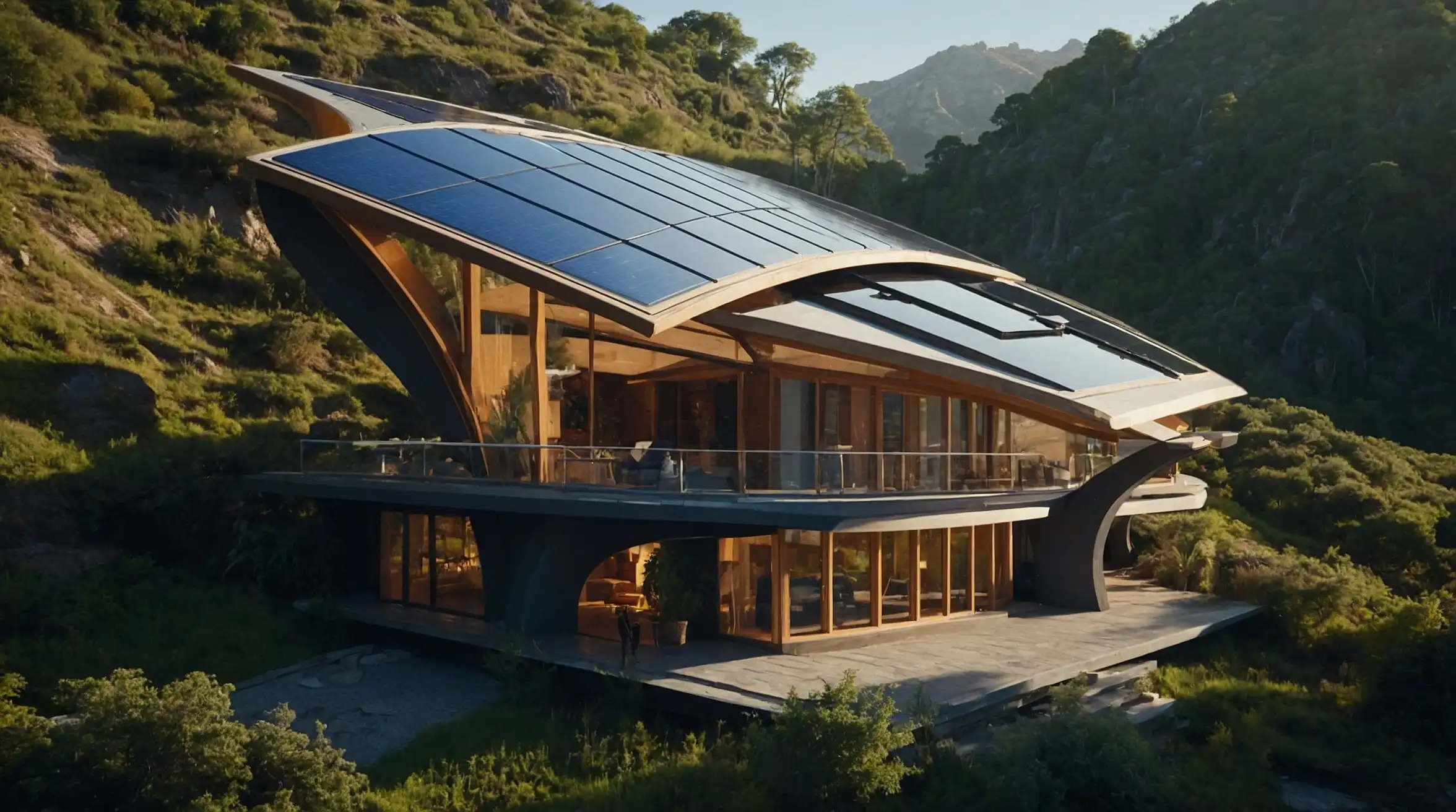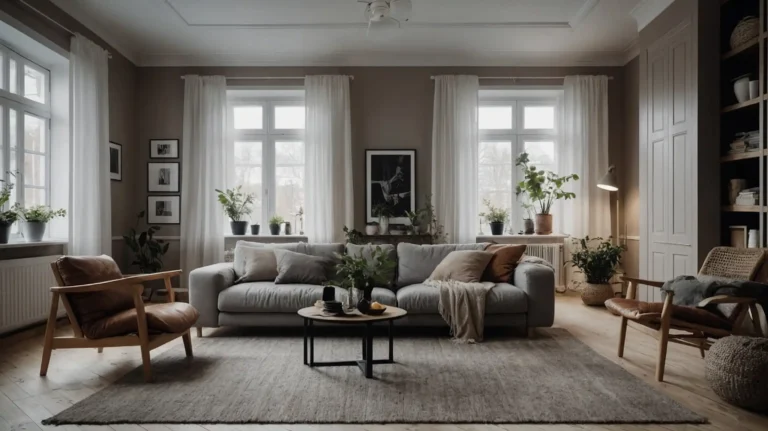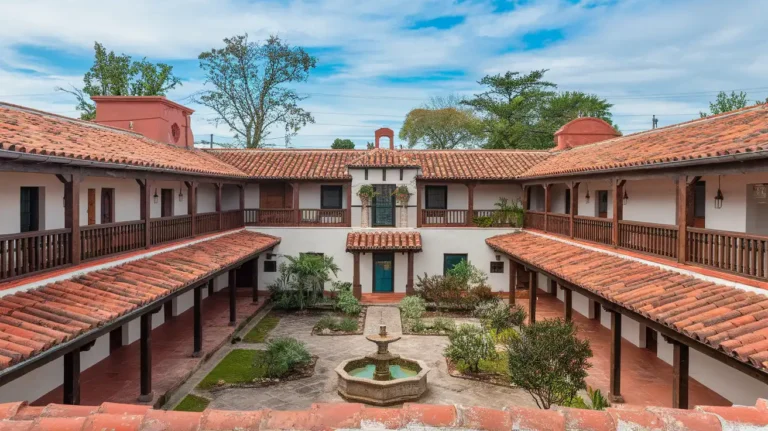27 Breathtaking Solarpunk House Ideas to Transform Your Living Space
Imagine living in a home that generates its own power, grows its own food, and connects harmoniously with the natural world.
Solarpunk architecture blends cutting-edge sustainability with natural aesthetics to create spaces that feel both futuristic and deeply rooted in nature.
These homes prioritize renewable energy, biophilic design, and community connection while showcasing the beauty of eco-conscious living.
They reject the dystopian view of our climate future and instead embrace optimistic, practical solutions.
Ready to reimagine your living space through a solarpunk lens?
These 27 ideas will inspire you to transform your home into a sustainable sanctuary that looks as good as it feels to live in.
1: Living Green Roofs

Replace traditional roofing with a thriving ecosystem of native plants.
Green roofs provide natural insulation, absorb rainwater, and create wildlife habitats while reducing the urban heat island effect.
Your roof becomes a functional garden that changes with the seasons.
The soil and vegetation layer protects your roof membrane, potentially doubling its lifespan compared to conventional roofing.
2: Transparent Solar Panel Windows

Install windows that generate electricity while maintaining transparency and views.
These innovative panels capture specific light wavelengths for power generation while allowing visible light to pass through.
You’ll enjoy natural daylighting without sacrificing energy production.
The subtle tinting adds architectural interest while demonstrating how technology can integrate seamlessly into beautiful design.
3: Vertical Hydroponic Gardens

Transform interior walls into lush growing spaces using vertical hydroponic systems.
These space-efficient gardens produce vegetables and herbs year-round while purifying your indoor air.
The cascading greenery creates a stunning living artwork.
You’ll appreciate the connection to your food source and the satisfaction of harvesting fresh produce steps from your kitchen.
4: Spiraling Staircases Around Living Trees

Build your home around existing trees, incorporating them into your architecture with spiral staircases that wind around their trunks.
This preserves mature trees while creating breathtaking interior focal points.
The tree becomes your home’s living centerpiece.
This biophilic approach recognizes the tree as your partner in creating a living space rather than an obstacle to be removed.
5: Rainwater Harvesting Art Installations

Collect rainwater with beautiful sculptural elements that double as collection systems.
These artful installations capture precipitation for household use while serving as striking architectural features.
Every rainfall becomes a performance as water flows through your artistic system.
You’ll find yourself looking forward to storms as opportunities to witness your home’s responsive, functional art.
6: Repurposed Shipping Container Studios

Transform shipping containers into bright, airy studio spaces or guest quarters.
These modular units offer strength and durability while giving new life to industrial materials that would otherwise require significant energy to recycle.
Extensive window cutouts flood the space with natural light.
The industrial aesthetic creates an interesting contrast with natural elements, embodying solarpunk’s blend of technology and nature.
7: Mycological Insulation Systems

Insulate your walls with mycelium-based materials grown from agricultural waste and fungal networks.
This compostable alternative to conventional insulation offers excellent thermal and acoustic properties.
You’ll enjoy a healthier indoor environment free from off-gassing chemicals.
The living materials connect your home to natural biological processes while providing superior performance.
8: Indoor Food Forests

Design multi-level indoor growing spaces that mimic natural forest ecosystems.
These carefully planned areas include fruit trees, shrubs, herbs, and ground covers that work together symbiotically.
Your home produces food year-round regardless of outside conditions.
The layered approach maximizes production while creating a lush, vibrant living space that changes with the seasons.
9: Biomimetic Solar Shade Structures

Install responsive exterior shading systems inspired by natural forms like leaves or flowers.
These dynamic structures adjust throughout the day to optimize solar gain in winter and provide shade in summer.
The beautiful, organic shapes cast ever-changing shadow patterns.
You’ll enjoy the performance benefits of precisely controlled sunlight while appreciating the artistic, nature-inspired movements.
10: Aquaponic Kitchen Systems

Integrate fish tanks with hydroponic growing beds in your kitchen area.
The fish provide nutrients for the plants, while the plants filter water for the fish, creating a beautiful closed-loop system.
Fresh herbs, greens, and fish become readily available for meals.
The bubbling water adds a soothing ambient sound to your living space while demonstrating ecological principles in action.
11: Passive Solar Sunspaces

Add a glass-enclosed sunspace that collects and distributes solar heat throughout your home.
These sunny rooms capture thermal energy during the day and gradually release it during evening hours.
The space doubles as a greenhouse and relaxation area.
You’ll naturally gravitate to this bright, warm area that demonstrates how good design can reduce or eliminate heating costs.
12: Algae Bioreactor Façades

Install transparent panels containing living algae on sun-exposed exterior walls.
These photobioreactors generate biomass for energy while providing dynamic green shading and carbon capture.
The bubbling panels change appearance throughout the day as the algae respond to light.
Your home becomes a living laboratory that actively improves environmental conditions rather than merely reducing harm.
13: Terra Cotta Cooling Systems

Cool your home naturally with modern interpretations of ancient evaporative cooling techniques.
Porous terra cotta elements allow water to slowly evaporate, creating natural air conditioning without electricity.
The earthy elements add warm architectural texture and color.
You’ll appreciate the connection to ancient wisdom reimagined through contemporary design principles.
14: Bioluminescent Pathway Lighting

Illuminate garden paths with bioluminescent plants and organisms that provide gentle lighting without electricity.
These living light sources create magical nighttime landscapes that connect you to natural cycles.
The subtle blue-green glow guides your way without light pollution.
This approach recognizes darkness as a valuable resource rather than something to be conquered with artificial lighting.
15: Hemp-Crete Construction

Build walls using hemp-crete, a biocomposite material made from hemp hurds and lime.
This carbon-negative alternative to concrete offers excellent insulation, moisture regulation, and fire resistance.
The natural material creates breathable walls that regulate humidity.
You’ll enjoy healthier indoor air quality while knowing your home actively sequesters carbon rather than producing emissions.
16: Butterfly Rooftop Water Collectors

Design roof systems shaped like butterfly wings that channel rainwater to central collection points.
These dramatic architectural elements make water harvesting visible and beautiful.
The distinctive silhouette becomes your home’s signature feature.
You’ll take pride in a design that celebrates rather than hides sustainable water management systems.
17: Sliding Greenhouse Walls

Install exterior walls that slide open, transforming indoor rooms into greenhouse spaces during favorable weather.
This flexible approach allows your living spaces to change with the seasons.
You’ll extend your growing season while blurring indoor-outdoor boundaries.
The transformable architecture responds to natural cycles rather than forcing constant artificial conditions.
18: Stone Thermal Battery Floors

Incorporate thick stone flooring that absorbs solar heat during the day and releases it slowly at night.
This passive approach to temperature regulation reduces or eliminates conventional heating needs.
The natural stone adds beautiful texture and visual interest.
You’ll enjoy the subtle warmth radiating from below during cool evenings, connecting you to the day’s stored sunshine.
19: Living Willow Structures

Grow living willow trees into architectural forms like domes, arches, or walls.
These structures strengthen over time as the willow branches graft together and develop thicker trunks.
Your architecture becomes a collaboration with natural growth processes.
The changing appearance throughout seasons—from bare sculptural forms to leafy green canopies—creates a dynamic living space.
20: Cork Bark Exterior Cladding

Finish exterior walls with sustainable cork bark that provides natural insulation.
This renewable material harvested without harming trees offers excellent thermal and acoustic properties.
The textured, varied surface creates visual interest and warmth.
You’ll appreciate how the material weathers beautifully over time, developing character while maintaining its performance benefits.
21: Gravity-Fed Water Distribution

Design your home’s water systems to use gravity rather than pumps whenever possible.
Strategic placement of collection tanks at high points allows water to flow naturally throughout your home.
This approach works silently without electricity or moving parts.
You’ll enjoy the resilience of a system that continues functioning during power outages while saving energy daily.
22: Seed Library Display Walls

Dedicate wall space to beautiful storage and display of seed collections.
These functional installations celebrate biodiversity while providing practical storage for your garden planning.
The organized collection becomes a striking visual element.
Your home actively participates in preserving genetic diversity while connecting you to seasonal cycles of planting and harvesting.
23: Composting Systems as Design Features

Transform waste management into a beautiful educational display using glass-fronted composting systems.
These installations demonstrate decomposition processes while producing valuable soil amendments.
The layered materials create interesting visual patterns that change over time.
You’ll develop a deeper appreciation for natural cycles by witnessing the transformation of waste into resources.
24: Solar Chimney Ventilation

Install solar chimneys that use temperature differentials to create natural air circulation.
These passive systems draw cool air through your home without mechanical fans or electricity.
The tall elements become distinctive architectural features.
You’ll enjoy the gentle, consistent airflow that maintains comfort while operating completely silently.
25: Curved Bamboo Support Structures

Replace conventional framing with curved bamboo structural elements.
This rapidly renewable material offers remarkable strength while creating graceful, organic interior spaces.
The visible structure becomes a key design element.
You’ll appreciate the warmth and visual rhythm of the natural material that reminds you of your home’s sustainable principles.
26: DIY Wind Turbine Sculptures

Generate power with artistic wind turbines that double as kinetic sculptures.
These vertical-axis designs capture energy at lower wind speeds while creating mesmerizing visual movement.
Each turbine becomes a statement piece reflecting your values.
You’ll find yourself watching their hypnotic motion while appreciating the direct connection to renewable energy production.
27: Microclimate Courtyards

Design interior courtyards that create specific microclimates for different plant communities.
These carefully engineered spaces might include desert gardens, tropical zones, or Mediterranean areas.
The diverse environments provide year-round connection to various ecosystems.
Your home becomes a bridge between different biomes while demonstrating how thoughtful design can create ideal growing conditions.
Conclusion
Solarpunk homes don’t just reduce environmental impact—they actively regenerate ecosystems while creating beautiful, nurturing spaces.
Start with one inspiring element that resonates with you and watch as your relationship with your home transforms.







